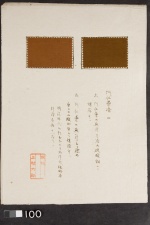Difference between revisions of "Asenyaku/Katekyu - left (100 L)"
Jump to navigation
Jump to search
(username removed) |
(username removed) |
||
| Line 5: | Line 5: | ||
| 100 | | 100 | ||
|- | |- | ||
| − | ! scope="row"| | + | ! scope="row"|Uemura number / title |
| − | | | + | | ; "Haze-some 25" |
|- | |- | ||
! scope="row"|Folder location | ! scope="row"|Folder location | ||
| Line 41: | Line 41: | ||
| - | | - | ||
|- | |- | ||
| − | ! scope="row"| | + | ! scope="row"|Uemura's notes |
| One of the Western natural dyeing techniques practiced during the Meiji period (1861-1912 AD), Japan. | | One of the Western natural dyeing techniques practiced during the Meiji period (1861-1912 AD), Japan. | ||
|- | |- | ||
| − | ! scope="row"| | + | ! scope="row"|Uemura's date |
| Kyoto | | Kyoto | ||
|} | |} | ||
| − | [[Category: | + | [[Category:Uemura dye archive]] |
Latest revision as of 06:17, 24 July 2013
| Museum number | 100 |
|---|---|
| Uemura number / title | ; "Haze-some 25" |
| Folder location | 2nd shelf |
| Sample location | left (100 L) |
| Fiber type | silk |
| Color | reddish brown |
| Dyestuff (Japanese common name) | 阿仙薬/カテキュ : Asenyaku/Katekyu |
| Dye (English common name) | Catechu/Cutch |
| Plant part | extract of young branches and leaves (?) /liquid |
| Dyestuff extraction | boiled with water |
| Auxiliary agent in dye bath | - |
| Mordant | potassium dichromate |
| Other auxiliary agent | - |
| Uemura's notes | One of the Western natural dyeing techniques practiced during the Meiji period (1861-1912 AD), Japan. |
| Uemura's date | Kyoto |
